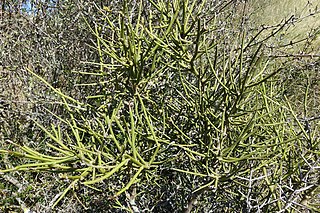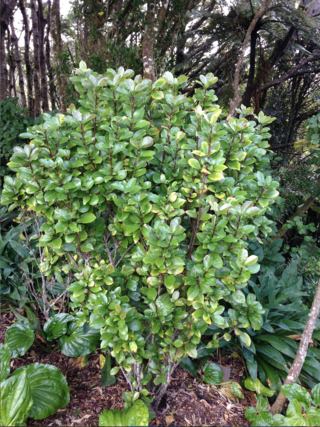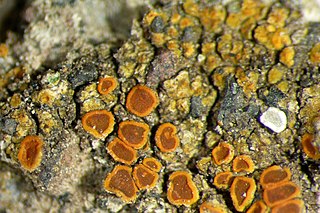
Veronica sect. Hebe is a group of plants within the genus Veronica, native to New Zealand, Rapa in French Polynesia, the Falkland Islands and South America. It was formerly treated as the separate genus Hebe. It includes about 90 species. Almost all species occur in New Zealand, apart from Veronica rapensis and Veronica salicifolia, found in South America. It is named after the Greek goddess of youth, Hebe. Informally, species in the section may be called shrubby veronicas or hebes.

Dacrydium cupressinum, commonly known as rimu, is a large evergreen coniferous tree endemic to the forests of New Zealand. It is a member of the southern conifer group, the podocarps.

Leptospermum scoparium, commonly called mānuka, mānuka myrtle, New Zealand teatree, broom tea-tree, or just tea tree, is a species of flowering plant in the myrtle family Myrtaceae, native to New Zealand and south-east Australia. Its nectar produces Mānuka honey.
Francis John Newhook was the head of the School of Plant Pathology at the University of Auckland, New Zealand. He was the first plant pathologist at the university, from 1966 as an Associate Professor, and from 1969 a personal chair. Previously he was a scientist at the DSIR.

Clianthus puniceus, common name kaka beak, is a species of flowering plant in the genus Clianthus of the legume family Fabaceae, native to New Zealand's North Island.
Victor Dmitrievich Zotov was a New Zealand botanist.

Carmichaelia glabrescens is a species of plant in the family Fabaceae. It is found only in New Zealand.

Raukaua simplex, or haumakāroa, is a species of evergreen plant in the Araliaceae family. This species is native to New Zealand. The species occurs in certain lowland, montane and subalpine forests from the Waihou River southward to Stewart Island and the Auckland Islands. An example occurrence in Westland forests includes associates such as Cyathea smithii and Dicksonia squarrosa.

Veronica salicifolia, synonym Hebe salicifolia, the koromiko, or willow-leaf hebe, is a flowering plant in the family Plantaginaceae, which is found throughout the South Island of New Zealand and in Chile. It is a large, evergreen shrub, reaching 2 m in height, with light-green, spear-shaped leaves that are up to 12 cm long, and white or pale lilac flowers.
Eric John Godley OBE, FRSNZ, Hon FLS, Hon DSc (Cantuar.), AHRNZIH was a New Zealand botanist and academic biographer. He is best known for his long-running series of in the popular magazine New Zealand Gardener and his "Biographical notes" series that ran in the New Zealand Botanical Society Newsletter and which is the prime resource on the lives of many New Zealand botanists.
Ruth Mason was a New Zealand botanist specialising in the taxonomy and ecology of freshwater plants. She was employed at the Department of Scientific and Industrial Research for 35 years undertaking research into aquatic plants, pioneering new techniques for plant preservation and collecting over 13,000 plant specimens in the field. She was awarded life membership by the New Zealand Ecological Society.

Carmichaelia petriei is a species of New Zealand broom in the genus Carmichaelia. It is endemic to New Zealand. C. petrieis is possibly a host plant for the critically endangered fungus weevil Cerius otagensis.
Peter Brian Heenan is a New Zealand botanist.

Actinotus novae-zelandiae is a plant in the Apiaceae family, native to the South Island of New Zealand.

Veronica jovellanoides, commonly known as Riverhead speedwell, is a threatened flowering plant in the family Plantaginaceae. It is endemic to New Zealand, where only three plants are known in the wild. All are found within the Ernest Morgan Reserve, a 20 ha forest northwest of Auckland. Its discovery is accredited to a retired plant nursery owner, Geoff Davidson, who organised the land's protection a few decades prior, and found it by chance on a walk in November 2007.

Alseuosmia quercifolia, commonly known as oak-leaved toropapa, toropapa, and karapapa (Māori), is a species of plant in the family Alseuosmiaceae. It grows as a shrub, reaching a height of 2.5 m, and has variably shaped glossy green leaves. Flowering begins in spring, producing fragrant pink flowers which become red berries in Autumn. Endemic to New Zealand, it is found only in the upper half of the North Island - predominately in the Waikato region.

Dracophyllum ophioliticum, commonly known as asbestos inaka and asbestos turpentine tree, is a species of shrub in the family Ericaceae. Endemic to New Zealand, it grows into a sprawling shrub, reaching heights of just 30–200 cm (10–80 in), and has leaves which form bunches at the end of its branches.

Caloplaca allanii is a species of saxicolous (rock-dwelling) and crustose lichen in the family Teloschistaceae. Found in New Zealand, it was formally described as a new species by Alexander Zahlbruckner. The type specimen was collected by Lucy Cranwell on Anawhata Beach in 1932; she sent a dried specimen to Zahlbruckner for identification. The specific epithet allanii honours New Zealand botanist Harry Allan.

Veronica obtusata, the northern hebe, is a flowering plant belonging to the family Plantaginaceae. It is native to northern New Zealand, and was first described by Thomas Cheeseman in 1916.

Te Rau-o-te-Huia / Mount Donald McLean is a hill in the Waitākere Ranges of the Auckland Region of New Zealand's North Island. It is located to the south of the ranges, near the township of Huia. It is the highest peak of the Waitākere Ranges that borders the Manukau Harbour.
















